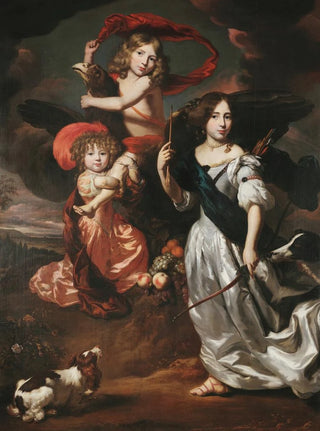Art print | Portrait of three children as Ceres, Ganymede, and Diana - Nicolaes Maes


View from behind

Frame (optional)
Portrait of three children in Ceres, Ganymede, and Diana - Nicolaes Maes – Captivating Introduction
The artwork "Portrait of three children in Ceres, Ganymede, and Diana" by Nicolaes Maes is a piece that evokes both the innocence of childhood and the richness of classical mythology. In this composition, the Dutch artist succeeds in capturing the very essence of childlike innocence while intertwining it with mythological references. The children, dressed in costumes reminiscent of mythological figures, seem to play a role in a scene that transcends everyday life. This piece is not limited to a simple depiction of children; it invites the viewer to immerse themselves in a universe where imagination and reality meet, creating an atmosphere that is both playful and contemplative.
Style and uniqueness of the artwork
Maes's work stands out for its technical mastery and keen sense of composition. The play of light and shadow, characteristic of chiaroscuro, gives striking depth to the children's faces. The delicate expressions, filled with curiosity and mischief, demonstrate attentive observation of human nature. The colors, carefully chosen, add warmth to the scene, emphasizing harmony between the characters and their environment. The juxtaposition of mythological figures with cheerful children creates a fascinating contrast that invites reflection on the nature of play and imagination. This artwork, through its unique style, transcends eras and continues to inspire art enthusiasts.
The artist and his influence
Nicolaes Maes, active in the 17th century, is often recognized as one of the greatest portraitists of his time. A pupil of Rembrandt, he mastered the master's techniques while developing a style that is uniquely his own. Maes specialized in depicting children and genre scenes, highlighting everyday life and human interactions. His influence is evident among many contemporary and later artists, who have been inspired by his ability to capture emotion and personality. By incorporating elements of mythology into his portraits, Maes paved the way for a new approach to portraiture, where the subject

Matte finish

View from behind

Frame (optional)
Portrait of three children in Ceres, Ganymede, and Diana - Nicolaes Maes – Captivating Introduction
The artwork "Portrait of three children in Ceres, Ganymede, and Diana" by Nicolaes Maes is a piece that evokes both the innocence of childhood and the richness of classical mythology. In this composition, the Dutch artist succeeds in capturing the very essence of childlike innocence while intertwining it with mythological references. The children, dressed in costumes reminiscent of mythological figures, seem to play a role in a scene that transcends everyday life. This piece is not limited to a simple depiction of children; it invites the viewer to immerse themselves in a universe where imagination and reality meet, creating an atmosphere that is both playful and contemplative.
Style and uniqueness of the artwork
Maes's work stands out for its technical mastery and keen sense of composition. The play of light and shadow, characteristic of chiaroscuro, gives striking depth to the children's faces. The delicate expressions, filled with curiosity and mischief, demonstrate attentive observation of human nature. The colors, carefully chosen, add warmth to the scene, emphasizing harmony between the characters and their environment. The juxtaposition of mythological figures with cheerful children creates a fascinating contrast that invites reflection on the nature of play and imagination. This artwork, through its unique style, transcends eras and continues to inspire art enthusiasts.
The artist and his influence
Nicolaes Maes, active in the 17th century, is often recognized as one of the greatest portraitists of his time. A pupil of Rembrandt, he mastered the master's techniques while developing a style that is uniquely his own. Maes specialized in depicting children and genre scenes, highlighting everyday life and human interactions. His influence is evident among many contemporary and later artists, who have been inspired by his ability to capture emotion and personality. By incorporating elements of mythology into his portraits, Maes paved the way for a new approach to portraiture, where the subject






